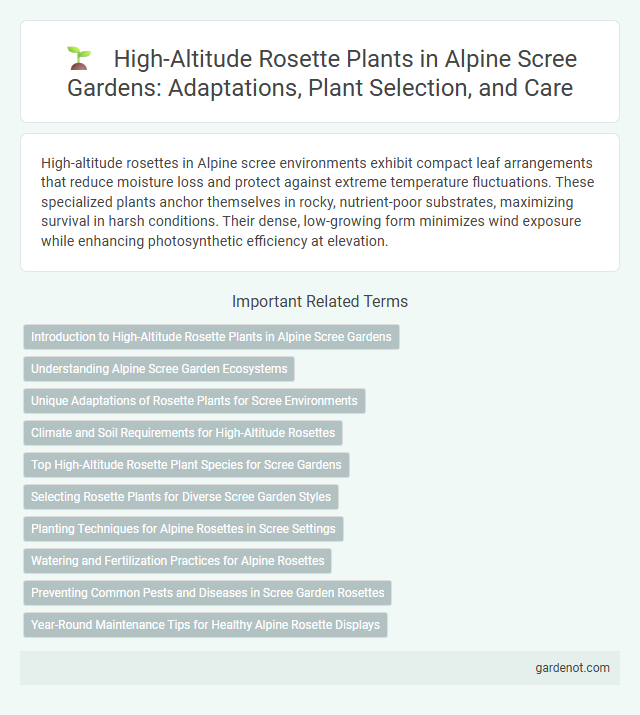High-altitude rosettes in Alpine scree environments exhibit compact leaf arrangements that reduce moisture loss and protect against extreme temperature fluctuations. These specialized plants anchor themselves in rocky, nutrient-poor substrates, maximizing survival in harsh conditions. Their dense, low-growing form minimizes wind exposure while enhancing photosynthetic efficiency at elevation.
Introduction to High-Altitude Rosette Plants in Alpine Scree Gardens
High-altitude rosette plants in alpine scree gardens exhibit specialized adaptations such as compact growth forms and dense leaf arrangements that minimize water loss and withstand extreme temperature fluctuations. These plants thrive in nutrient-poor, well-drained scree environments, where their rosette structure protects meristematic tissues from frost and mechanical damage. Common alpine rosette species include Saxifraga oppositifolia and Silene acaulis, both critical for maintaining biodiversity and stabilizing fragile scree slopes.
Understanding Alpine Scree Garden Ecosystems
High-altitude rosette plants thrive in Alpine scree by adapting to extreme conditions such as intense UV exposure, low temperatures, and nutrient-poor, unstable substrates. These rosettes stabilize scree slopes by preventing soil erosion and creating microhabitats that support diverse flora and fauna. Understanding their physiological adaptations and ecological roles is essential for conserving fragile Alpine scree garden ecosystems amid climate change.
Unique Adaptations of Rosette Plants for Scree Environments
High-altitude rosette plants exhibit unique adaptations that enable survival in harsh scree environments, including compact leaf arrangements that minimize water loss and protect against cold temperatures. Their deep root systems anchor them in loose, unstable scree, facilitating nutrient absorption and stability on steep slopes. Specialized photosynthetic pathways optimize energy efficiency under intense UV radiation and limited soil nutrients typical of alpine scree habitats.
Climate and Soil Requirements for High-Altitude Rosettes
High-altitude rosette plants thrive in alpine scree where well-drained, nutrient-poor soils with coarse texture dominate. These plants are adapted to withstand extreme temperature fluctuations, frost, and intense solar radiation typical of high-altitude climates above 2,500 meters. Moisture retention is critical, so these rosettes often grow in microhabitats with intermittent snowmelt or dew to sustain their water needs despite harsh environmental conditions.
Top High-Altitude Rosette Plant Species for Scree Gardens
Top high-altitude rosette plant species for scree gardens include Saxifraga oppositifolia, Silene acaulis, and Androsace alpina, all adapted to survive in harsh alpine scree conditions. These plants exhibit compact, low-growing rosettes that minimize water loss and resist wind damage, making them ideal for rocky, nutrient-poor environments. Their ability to thrive at elevations above 3,000 meters supports biodiversity and soil stabilization in fragile mountain ecosystems.
Selecting Rosette Plants for Diverse Scree Garden Styles
High-altitude rosette plants, such as Saxifraga and Androsace species, thrive in Alpine scree environments due to their compact growth and drought tolerance. Selecting rosette plants for diverse scree garden styles involves prioritizing species with varied leaf textures, colors, and flowering times to create visual interest and mimic natural alpine conditions. These plants' adaptability to poor, well-drained soils and extreme temperature fluctuations makes them essential for sustainable and resilient scree garden designs.
Planting Techniques for Alpine Rosettes in Scree Settings
High-altitude rosettes thrive in scree settings by utilizing planting techniques that prioritize deep-root anchorage and substrate stabilization. Incorporating coarse, well-draining materials such as gravel and sand mimics natural scree habitats, promoting root aeration and moisture retention. Strategic placement in micro-depressions or sheltered crevices enhances protection against extreme winds and temperature fluctuations, ensuring optimal growth and survival in alpine environments.
Watering and Fertilization Practices for Alpine Rosettes
Alpine rosettes thrive in well-drained, rocky soils typical of scree environments, requiring minimal but consistent watering to mimic natural moisture levels without causing root rot. Fertilization should be sparse, using a balanced, low-nitrogen fertilizer to support slow growth and enhance resilience to harsh alpine conditions. Maintaining proper watering schedules combined with light, infrequent feeding promotes robust root systems and vibrant leaf development in high-altitude rosettes.
Preventing Common Pests and Diseases in Scree Garden Rosettes
High-altitude rosettes in alpine scree gardens often face threats from aphids, slugs, and fungal infections. Employing well-drained soil and maintaining proper air circulation reduces fungal spores and slug habitats, while natural predators like ladybugs help control aphid populations. Regular inspection and removing affected leaves ensure the health and vitality of scree garden rosettes in challenging alpine conditions.
Year-Round Maintenance Tips for Healthy Alpine Rosette Displays
High-altitude rosette plants thrive in alpine scree environments by benefiting from well-drained, rocky soils and consistent moisture management. To maintain healthy year-round displays, ensure proper mulching with mineral grit to protect roots from frost while promoting air circulation to prevent fungal diseases. Seasonal pruning of damaged leaves enhances growth and preserves the symmetrical, compact form essential for alpine aesthetics.
High-altitude rosette Infographic

 gardenot.com
gardenot.com